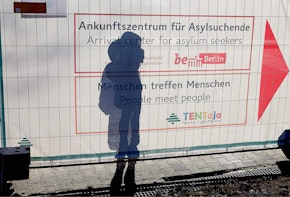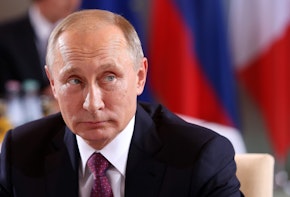Order from Ashes: New Foundations for Security in the Middle East is the result of a multiyear project by The Century Foundation (TCF), supported by the Carnegie Corporation of New York. The project was conceived in 2015, as it became starkly evident that the period of optimism and promise that followed the genuine political openings created by the Arab uprisings had been eclipsed by the violence, repression, and polarization that followed. Those effects could be seen not only within states but also between and among them. The project began with the assumption that the Middle East’s political and security order badly needs reforms and holistic consideration, with a focus on individual political circumstances in key countries and the regional order as a whole. National dynamics affect regional dynamics and vice versa, and this project was intended to examine them both separately and together.
Regional political leaders have invoked external security threats, both real and imagined, to justify repression of their publics and their own refusal to engage in serious domestic political reform. However, any examination of the regional security environment makes it clear that the region faces real threats from nonstate actors, proxy forces, and interstate rivalry and conflict against a backdrop of sectarian polarization and radicalization. Throughout the region, legitimate fears merge with imaginary threats to create a reactionary climate, often with significant public support. The editors take seriously the regional perceptions of these threats, as they simultaneously inform regional security posture and domestic political choices. Questions of security and reform cannot be raised in isolation. Ideally, any effective conversation about regional reform and stability would address the tangible security threats, sometimes exaggerated fears, and visceral domestic politics that underlie the decisions of largely autocratic governments.
In 2017, contributors to the project published an edited project titled Arab Politics beyond the Uprisings: Experiments in an Age of Resurgent Authoritarianism. This book sought to examine the political energies shaping the region, in a positive and negative sense, following the period of uprisings and mass mobilizations of 2010–11. It was agnostic as to the ultimate outcome of the continuing contestation for political expression, control, and legitimacy. Yet at the same time, it sought to broaden the analysis of what we deem to be political in an effort to garner a more comprehensive view of politics in the region today, exploring the effects not only within the confines of traditional high politics, but also in such spheres as ideology, civil society, culture and media, and subnational governance. Those assessments were generally country-specific, even though the impact of those trends transcends the geographic and political boundaries within which they originate.
Order from Ashes seeks to examine the current regional security environment at a time of perhaps unprecedented turmoil and instability. It does this while also offering insight and prescriptions for managing this moment, and for thinking more constructively about longer-term efforts to construct peace and security architecture. Although the region has experienced devastating interstate wars in the past, the cumulative impact of escalating violence, eroding and failing states, sharpened threat perceptions, and increasing spillover effects renders the current juncture grim and brittle. It also perpetuates the international community’s disproportionate focus on the region. Heightening the risks of this moment is the fact that the Middle East suffers from a unique deficit in its peace and security architecture, even when compared to similarly fractious or unevenly developed regions. This deficit is an outgrowth of the region’s persistent and chronic conflicts, its tense geopolitics, and the ubiquity of international involvement and intervention. Past attempts to build peace and security architecture have failed to galvanize key stakeholders in their efforts to remedy the destabilizing consequences of this lack of structure, even in the face of periodic crises and deteriorating conditions that such a structure could help address. The dysfunctional and tense political relationships that mark the region and the strategic importance accorded to it by global powers have shifted the locus of decision-making and strategic planning away from regional actors and organizations, and toward outside players. But no matter what has caused this ongoing security deficit, the lack of formal security mechanisms creates further dangers and risks for an already unstable and critical region.
Order from Ashes
This report is part of “Order from Ashes: New Foundations for Security in the Middle East,” a multiyear TCF project supported by the Carnegie Corporation of New York.
The idea of creating a cooperative regional security framework for the Middle East is by no means a new one, but the region’s often rigid lines of conflict and diplomacy have undermined previous efforts. The most sustained and focused such effort came in the 1990s as an outgrowth of the Madrid Peace Conference. Regional states, pushed by outside powers, recognized the importance of a more robust security architecture and established the Arms Control and Regional Security (ACRS) working group. Even though this initiative had encouraging prospects at the outset, it quickly stalled and failed. Subsequent crises failed to revive it. The Second Intifada, the Arab Peace Initiative, the 2003 U.S. invasion of Iraq and the subsequent civil war and regional proxy war there, the ongoing conflicts in Syria, the protracted war in Yemen, and heightened Saudi-Iranian tensions all have highlighted the need for a Middle East security architecture. But rather than catalyzing meaningful attempts to craft such an architecture, the region’s perpetual strife has instead blunted any impetus to build one.
Nonetheless, the ambitious, long-term project of creating more formal security architecture and institutions can facilitate greater cooperation, which is essential in light of the transnational problems facing the Middle East. The efforts themselves—even aside from their success in creating a robust security architecture—can also mitigate the risks of conflict escalation. Such efforts will help to establish norms and expectations regarding state behavior. Working to institutionalize such norms will create greater regional consensus and more effective means for shaping state behavior and dealing with transgressions. It will also be essential if the United States is to create a more rational and sustainable regional policy, one that adopts a more balanced posture in keeping with its actual interests. Most important, seeding and nurturing regional mechanisms to prevent, manage, and end conflicts could have a demonstrable and material impact on the lives of the region’s citizens.
The effort to foster regional security dialogue and construct regional security mechanisms remains a fraught task that is unlikely to follow a linear, orderly design and implementation process. Academic and policy research on security cooperation has often failed to influence the region’s security agenda. Sound proposals have most frequently collapsed in the face of the region’s deteriorating security situation, but new ideas are urgently needed to push the conversation forward, as regional polarization increases and spillover effects multiply. Even if the prospects for robust regional security dialogue appear more distant than ever, the need for a regional framework to avoid, manage, and mitigate security crises has never been more acute. Escalating conflicts have multiplied the dangers inherent in a regional security breakdown, but they also create new opportunities to manage security relationships in order to mitigate those heightened risks.
Regional leaders’ heightened considerations for their own concerns and fears has made the Middle East’s political landscape increasingly unpredictable, but also perhaps more ripe than ever for carefully crafted prescriptions. Within the region, leaders have begun to discuss coordinated initiatives such as joint security forces. Arab leaders are also entertaining tighter political and security coordination, often in the form of wider and deeper partnerships between regimes that share a common perceived agenda. Such developments often have had counterproductive and destabilizing outcomes, but political, economic, and security collaboration is more open for discussion than at any period since the end of the Cold War sparked a brief moment of creative proposals. Key regional and outside parties, chief among them the United States, are seeking to acclimatize to this new security environment. At present, players across the region are reappraising their regional security strategies and rethinking approaches to collective defense. This period of transition has created its own risks of turbulence and miscalculation. Those shifts will have a profound impact on regional conditions, not least because such adjustments run the risk of exacerbating the current regional predicament by further militarizing responses to instability and insecurity.
The region’s shifting geopolitics have contributed to escalating levels of violence and sectarianism, but also might prompt old foes to negotiate new positions with each other. With luck and proper steering, that impulse for negotiation would not necessarily harden existing positions; instead, it could lead to a sober reexamination of how to govern heterogeneous societies and relate to neighboring countries with multiple affinities. The process by which regional security dialogue can produce concrete results is not independent of the region’s broader trends, but it offers legitimate opportunities for discrete but potentially productive areas of engagement. Those opportunities may in turn engender greater trust and galvanize other confidence- and peace-building steps. Meaningful progress on this front, at the onset, will not be the result of grand institutional design. It is more likely that it will grow from incremental or sectoral initiatives.
This project has been organized into four sections: past and present efforts to undertake regional security dialogue; current efforts at adapting regional security strategy and fashioning approaches to collective defense; the future of regional security dialogue; and confidence- and security-building measures. The first section begins with Dalia Dassa Kaye’s assessment of the prospects for regional security cooperation. She reviews previous unsuccessful attempts and summarizes key lessons learned, and recommends practicable ways to begin to create a Middle East multilateral security forum that may avoid the mistakes of the past. Peter Jones examines the impact of back-channel discussions on regional security matters that have reportedly taken place between Israel and various Arab states. Jones states that even though back-channel diplomatic engagements invite significant optimism in some quarters, only modest progress should be expected from them. Absent a major political breakthrough on the core issues that define the Arab-Israeli conflict, Jones argues that back-channel regional security discussions do not create a likely pathway for normalizing relations or building a regional security architecture. Nasser bin Nasser and Jasmine Auda offer an overview of the factors that have led to the region’s current state of affairs and the lack of a robust institutionalized security architecture. They highlight, however, that even though states in the region have not adopted the frameworks and mechanisms typical of other security communities, they nonetheless are engaged in cooperative security efforts that build upon localized, regional traditions. As a result, Nasser and Auda stress, observers should not necessarily assume that other regional models are the best template for a more comprehensive security architecture. Thanassis Cambanis, the coeditor of this project, examines the ongoing tripartite talks between the Israeli and Lebanese militaries, which are facilitated by the United Nations Interim Force in Lebanon (UNIFIL). These talks are distinctive in a region where dialogue among belligerents is rare. UNIFIL’s indirect channel between Israel and Hezbollah has been a limited success. It has helped to avoid accidental conflict escalation and provides a positive model for conflict management. However, as Cambanis points out, these incremental benefits cannot substitute for the political solutions required to create the basis for a sustainable peace.
The second section delves into current efforts to adapt regional security strategy and fashion approaches to collective defense. Much of this discussion is not directly concerned with ongoing efforts at cooperative security, but these reports provide important insights into the broader regional security environment. Bruce Jentleson focuses his attention on the United States’ regional strategy, which he argues is in dire need of an overhaul—a need that the presidency of Donald Trump has further magnified. Jentleson proposes a strategic recalibration for the United States that would shift its approach from regional dominance to regional balance, move beyond blind support for traditional Arab allies, pursue possibilities for major improvements in U.S.-Iranian relations despite ongoing tensions, and redouble support for a two-state solution to the Israeli-Palestinian conflict. Emile Hokayem and David B. Roberts analyze shifting regional security strategies among the Arab states of the Gulf. They pay particular attention to the search for security partnerships and alliances, which they characterize as the main approach by which these states seek to ensure their survival, stability, and security. With the United States changing its regional role and seeking to lessen its regional burdens, the Arab Gulf states have begun to hedge their reliance on external partners. However, this search for security partners has sharpened rivalries among them. With the Trump era introducing greater uncertainty into the region, Hokayem and Roberts suggest that these trends are likely to continue and that these security relationships will become even more fragmented. Brian Katulis offers an assessment of Middle East security integration, which has received renewed attention in recent years as major regional players have put the issue on the regional agenda. Katulis reviews the history of previous attempts at coordination, and argues that the region continues to suffer from a profound lack of meaningful security cooperation. Although the prospects for such collaboration remain bleak, he argues that the potential gains would be significant not only for regional security and stability, but also for the United States, which could focus on wielding its power more effectively in the region.
The third section examines the future of regional security dialogue, and grapples with the thorny but unavoidable issue of non-Arab regional and outside parties and their role in Middle Eastern security efforts. Among the greatest challenges facing regional security dialogue is the absence of effective mechanisms for dialogue in the region, owing to the lack of diplomatic links among foes and the persistence of conflict. As a result of this disconnect, key nodes of conflict and key states remain outside the reach of formal diplomacy. Further, even though language and culture link much of the Middle East, the power of major non-Arab countries—Iran, Israel, and Turkey—creates additional complications and gaps. In many instances, the mere act of open dialogue remains impossible. Against this challenging backdrop, these reports offer perspectives on the future of regional security dialogue in the Middle East. Selim Can Sazak and Caglar Kurc argue that Turkey’s reengagement with the Middle East was driven primarily by security concerns and not by economic or identity issues. Even though Turkey’s “zero-problems” doctrine faltered upon multiple lines of regional conflict, Sazak and Kurc argue that it may still be possible to engage Turkey in multilateral diplomacy for regional security because it continues to view the region through a security-focused lens. Emily B. Landau examines the prospects for Arab-Israeli security dialogue in the context of major shifts in the Middle East in recent years. She argues that regional realignments and changing threat perceptions highlight the need for a regional security dialogue framework. The shifting nature of regional geopolitics, security relationships, and state interests has created new opportunities to include Israel in such dialogue. To be successful, Landau states, security dialogue must incorporate lessons from previous experiences, including the notion that creating a viable process is more critical than expecting immediate results. Dina Esfandiary offers her analysis of Iran’s regional interests and its views on regional security dialogue. She argues that even though Iran’s interests often put it in tension and conflict with other regional countries, particularly in the Gulf, it does not intend to simply destabilize the region. Rather, she claims, Iran is intent on securing itself and expanding its influence. Understanding these motivations, which are similar to those of its neighbors, is critical to efforts to construct a productive regional security dialogue that includes Iran. Bassel Salloukh grapples with the increasing and often destructive importance of armed nonstate actors, whose power and influence have increased as the Arab state system has eroded. As conflict and state fragmentation accelerate, Salloukh claims, stability will be possible only through messy but necessary bargains at both domestic and regional levels. Domestic bargains will involve consociational agreements that accommodate each state’s sectarian, ethnic, and tribal groups. From there, regional stability will require a grand geopolitical bargain that begins to define spheres of influence among the main international and regional actors vying for influence in the Middle East. Salloukh argues such an outcome may be far from ideal, but it could produce a functioning equilibrium superior to the current dysfunction and instability.
The final section provides recommendations for security- and confidence-building measures that can both decrease tensions and establish security cooperation precedents. These contributions all offer practicable, actionable policy recommendations that could immediately inform Track Two discussions and influence regional and international discourse on constructive future policy options. David Griffiths argues for the great potential of maritime confidence- and cooperation-building, which often provide a less fraught pathway to regional cooperation. Griffiths builds upon his years of experience in supporting and participating in the region’s underappreciated efforts at developing mechanisms for regional maritime security and safety. Previous channels of communication, which initially were part of ACRS, could be a useful mechanism for restarting discussions even in a tense regional climate. Maritime cooperation could thus directly enhance regional security in practical ways and simultaneously create precedents for cooperation. Bilal Saab and Nilsu Goren address the potential for developing a regional nuclear security framework, which they argue is a logical starting point for cooperative regional security efforts. In security terms, the prevention of nuclear attacks and accidents is a lowest common denominator, even for a region wracked by conflict and strategic competition. With demand for nuclear power likely to grow in the future, the urgency for such cooperation will also increase. Working on a related theme, Selim Can Sazak suggests that the allure of and likely increase in the use of nuclear power is an opportunity for cooperative efforts to address regional problems. Sazak sees those cooperative efforts as an avenue to help manage the challenges presented by the linked issues of food, water, and energy, provided that the development of nuclear energy is undertaken with thought and care. Additionally, such a cooperative effort could have broader and salutary effects on regional security and stability. Finally, this editor’s contribution looks at the potential for building capacity for regional coordination to prevent and manage conflict. Those capacities remain woefully underdeveloped, reflecting the region’s broader geopolitical dynamics. Nonetheless, this final report argues that regional countries and interested outside parties should invest now in low-key efforts to help build conflict-prevention capacity. Even if those efforts will be tied to and undermined by the region’s political, diplomatic, and security divides, this sort of preparatory and necessary work still has value and utility.
No project of this sort can aspire to be wholly comprehensive, and many worthy topics of inquiry remain, including a cooperative approach to the threat of chemical weapons (a uniquely pressing threat for the Middle East), divergent Arab perceptions of threat, regional approaches to postconflict humanitarian assistance and reconstruction, and comparative studies examining the applicable lessons learned from other regional security experiences. However, in bringing together this diverse set of contributors, representing a wide spectrum of views and specialties, the editors hoped to provide a variety of perspectives on both recent history and the way forward. As in this project’s previous volume, these contributions reinforce the practice of policy scholarship that is rooted in rigorous methodology but is squarely aimed at having tangible impact on public policy discussions and practice.










